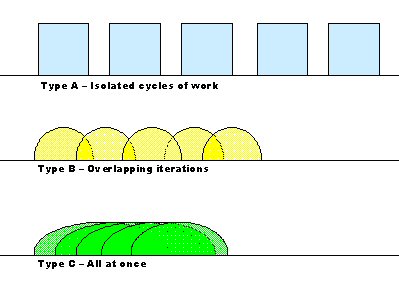Scrum Evolution: Type A, B, and C Sprints

Figure 1: Type A, B, and C strategies for delivering product [1].
One of the key influences that led to creation of the first Scrum was a paper on the Japanese way of new product development by Takeuchi and Nonaka [2]. This paper had a chart showing product development separated into silo’s (Type A), phases slightly overlapped (Type B), and all phases of development overlapping (Type C). Type A, the Japanese viewed as an outmoded relay race type of process. Type C they envisioned as Scrum where all phases of product development were overlapping. One can reinterpret this diagram at a higher level and think of it as applying to different types of Scrum execution. A Type A Scrum does all work on a Sprint within the timebox of the Sprint, which results in downtime when reorganizing for the next Sprint. By adding product definition tasks for the next Sprint into the current Sprint, a Type B Sprint allows work to flow smoothly from Sprint to Sprint. A Type C Sprint, often called Continuous Sprint, runs multiple overlapping Sprints through the same Scrum teams.
1. Takeuchi, H. and I. Nonaka, Hitotsubashi on Knowledge Management. 2004, Singapore: John Wiley & Sons (Asia).
2. Takeuchi, H. and I. Nonaka, The New New Product Development Game. Harvard Business Review, 1986(January-February).
 Scrum is an Agile development framework that Jeff Sutherland invented at Easel Corporation in 1993. Jeff worked with Ken Schwaber to formalize Scrum at
Scrum is an Agile development framework that Jeff Sutherland invented at Easel Corporation in 1993. Jeff worked with Ken Schwaber to formalize Scrum at 

2 Comments:
Hi Jeff, I now this post was created 4 years ago (almost no point in leaving a comment), but for me, even though Type B is preferred and Type A is, somehow, interesting to give developers a breather, Type C is what I often see happening in projects, as products evolve a lot and there is almost no way of telling when a certain sprint ends or when the next begins (yeah, nearly mayhen)
That said, I really wouldn't say type C really represents a difference from not having any methodology
The difference is that Type C at PatientKeeper runs 10 times as fast as a waterfall team and delivers into production at 5-10 hospitals at the end of every Sprint. This is a little bit different than no methodology. In fact, it requires extreme discipline, more than you will see in other companies.
Post a Comment
<< Home